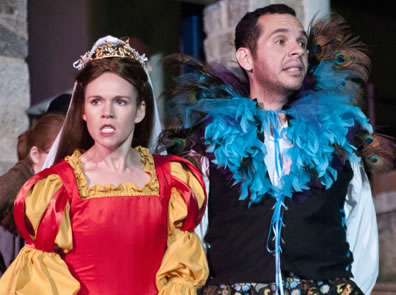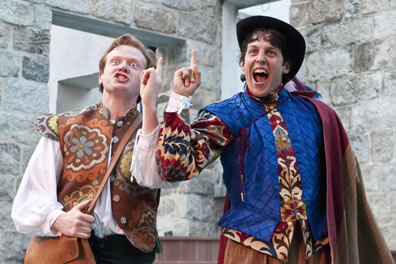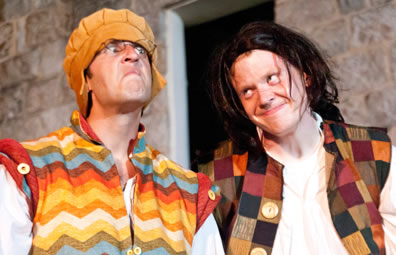The Taming of the Shrew
Smart Theater, Brainless Fun
Chesapeake Shakespeare Company, Patapsco Female Institute Historic Park, Ellicott City, Md.
Friday, June 22, 2013, Fifth rowish, four seats to the left of center
Directed by Ian Gallanar
Sometimes, you don't want to think; intellectual pursuits seem overrated; and the only deep feeling you seek is a belly laugh. If that's your state of mind, the Chesapeake Shakespeare Company's Taming of the Shrew is just the ticket.

Molly Moores as Kate, Jose Guzman as Petruchio in The Taming of the Shrew. Photo by Teresa Castracane, Chesapeake Shakespere Company.
This is a production that eschews the misogyny debate, refusing to trouble itself with whether Petruchio is cruel and Kate abused, or how women are merely chattel to the men. This is a production that sets aside the discussion of trust, refusing to explore Kate's psychosis and Petruchio's insight, or how women manipulate men to their purposes. Rather than feminism or Freudianism, this production focuses on fun.
If Kate has a backstory, it's as a WWE diva. Molly Moores as Kate first appears as a she-devil in red, emerging from the flames of hell gnashing her teeth to the tune of "Eye of the Tiger." She not only attacks the men on stage but goes into the audience to attack a man there, and then she cuts the string of a balloon tied to a little child's wrist and maniacally laughs as it floats into the air. If Petruchio has a backstory, it's as an arena rock star. Jose Guzman as Petruchio first appears rising from under the stage in billowing smoke and does a spot-on James Brown concert-closing routine, complete with Grumio laying on the glittering cape.
First impressions are indicative of where this play will go. Even the preshow announcement lights are way, informing us that, for the Punch and Judy Show, due to an unfortunate accident to Judy, her part will be played by Elmo (an aborted puppet show, along with a juggling act, and madcap rioting on the stage replaces the Induction in this production). Lasting impressions of this evening of Shakespearean theater include the cast singing Harry Nillson's "Put the Lime in the Coconut" at the start of the play's second half (no, this choice of song has nothing whatsoever to do with the play or this production's setting), a slow-motion fight with Vincentio using a fish as a weapon, and a weird musical interlude covering a costume change. That's all absolutely OK, as Shakespeare obviously meant this play to be first and foremost a laughfest, and that's exactly what the director, CSC's Founding Artistic Director, Ian Gallanar aims to give us.
I believe, along with maybe too few scholars, that The Taming of the Shrew might be Shakespeare's first play. It seems the work of a young playwright giving wing to his talents by using an established framework of stock characters and plotline. That stock comes from commedia dell'arte, a theatrical format originating in Italy earlier in the 16th century and well known in England by the time Shakespeare arrived in London to work in the theaters there. Shakespeare, being the Shakespeare he would become, perhaps infused, even this early in his career, some of his humanist notions into the story (Petruchio's discourse to Kate that '''tis the mind that makes the body rich" is as stellar a passage as any in the whole canon), but this play is pretty much his stab at commedia dell'arte comedy.
Gallanar stages a commedia dell'arte-style presentation sans the masks. The characters are costumed and behave as caricatures. The action is bold, including the cartoonish violence worked into the proceedings, from Kate laying a beating on Petruchio to Vincentio's wielding the fish as he's threatened with arrest. The actors directly engage the audience, from Kate's attack on the patrons to the use of a member of the audience to play a speaking role in the play. The actors even spend time in among the audience spread out on the lawn of the open-air theater set into the ruined walls of the Patapsco Female Institute. Characters help themselves to picnics, and Grumio (James Jager) sitting in the audience led to this opening night exchange after Petruchio berated the Tailor about the dress he made for Kate:
Tailor (to Petruchio): "The gown is made just as my master had direction. Grumio gave order how it should be done."
Little Girl in the audience (to Grumio): "You're busted!"
Grumio (to Little Girl): "I'm busted! You're busted! " (To Petruchio) "I gave him no order, I gave him the stuff."
Costume designer Kristina Lambdin dresses the characters in elaborately fanciful Elizabethan dress, and combining this costuming with the fact that Gallanar has cast only eight actors to play the principal parts gives us that incongruous musical interlude when Lauren M. Davis must change out of Bianca's blue dress into the Pedant's wild merchant's suit in Act Four, Scene One. A guitarist, a harmonica player, and a woman bearing a sign explaining that this interlude is for a costume change cross the stage as Tranio and Biondello wait patiently. Then, after a pause when Davis is not quite ready, the trio return back over the stage with the harmonica player losing breath and giving out halfway across the stage.
Some productions use farce as a proven strategy to cover up their lack of understanding of Shakespeare's verse or their inability to play it well. That's not the case here. Under Gallanar's sure-handed direction, this production succeeds on the company's Shakespearean skills as well as its theatrical talents. The play's lines get as many genuine laughs as do the actors' antics. Such are the costumes that it's not at all readily obvious that, for example, Jager playing Grumio is also Lucentio—I didn't figure that out until after the performance when I checked the cast list, a credit to Jager's acting abilities as well as his costume. Greg Burgess doubles Hortensio and Vincentio, making the former a whining effete man and the latter a narcoleptic senior. Matthew Ancarrow doubles as a clever Tranio and a clueless Curtis, and Frank B. Moorman moves from a constantly bewildered Baptista to a Haberdasher who regards Petruchio as a curiosity. Vince Eisenson does triple duty as the elderly Gremio, the carefree and energetic Biondello, and the snobbish Tailor. Whichever role he's in, Eisenson earns laughs as much for his facial expressions as his droll line readings.
Guzman plays Petruchio with a flourishing bravado and a fully assured ego, even as he's being kicked, punched, and tossed about by Kate. He shows up at the wedding so drunk (as is Grumio) that he roars like a belligerent Phillies fan in the seventh inning. However, Guzman has masterful command of the verse, and, despite his over-the-top take on Petruchio, he gives the character real heart. Fittingly if not ironically, in a production of visual fancy and fun, Petruchio's speech to Kate about the mind making the body rich serves as the play's true soul, as Guzman delivers these lines with a quieting Zen wisdom. "What, is the jay more precious than the lark because his feathers are more beautiful? Or is the adder better than the eel because his painted skin contents the eye? O no, good Kate, neither art thou the worse for this poor furniture and mean array."


Top, Tranio (Matthew Ancarrow, left) and Lucentio (James Jager) arrive at an idea shortly after arriving in Padua. Bottom, the two actors play Grumio (James Jager, left) and Curtis (Matthew Ancarrow) prior to their master arriving at his country home. Photos by Teresa Castracen, Chesapeake Shakespeare Company.
Perhaps Moores's Kate falls completely in love with Petruchio at this point—she seems to be pleased with how Petruchio looks when they first meet—but the actress does not make that clear. This production is less about detailing Kate's arc of understanding than it is in giving us funny set pieces of Kate's change in attitude. In the final scene, Moores winks at Petruchio when he orders her to fetch the other women, indicating she's aware that he's up to something and will go along with him. She thus gives Kate's famous final speech a straightforward reading, maybe with a bit of cheek but certainly no irony. As Kate offers her hand to Petruchio, he instead pulls a chair out for her to sit in, and then with his "Why, there's a wench!" he kneels and places his hand under her foot instead. "Come on, and kiss me, Kate," he says, and she is more than willing to do so. It's a sweet moment, though we're not entirely sure how she got there psychologically.
But, again, so what? There's other matter in this scene for us to chew on. Shakespeare wrote 13 speaking parts; Gallanar has only eight actors (plus extras as the servants). He leaves some characters out, such as the Pedant (allowing Davis to be just Bianca) and Grumio (so that Jager can remain Lucentio); instead of sending Grumio to fetch Kate, Petruchio, as Lucentio and Hortensio do before him, sends Biondello to fetch his wife. However, Gallanar uses a novel casting device for the part of Hortensio's wife, the Widow; she is played by somebody selected from the audience, dressed in proper Elizabethan mourning dress and keeping a fan to her face. Of course, her mere appearance is bound to generate a laugh, especially if it's a man selected, and three more are guaranteed when the Widow speaks her three lines, just for the mere fact that it's one of us playing the part. On opening night, that actor was Earle Pratt, president of CSC's Board of Trustees, and he requited himself well in the role.
That was entirely fitting for this production. This is a Taming of the Shrew that doesn't take itself seriously but has some seriously good talent that makes it genuinely funny on every level.
Eric Minton
June 27, 2013
This review also appears on PlayShakespeare.com
Comment: e-mail editorial@shakespeareances.com
Start a discussion in the Bardroom



 Find additional Shakespeareances
Find additional Shakespeareances